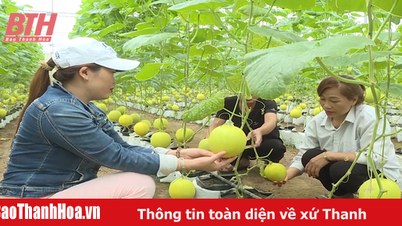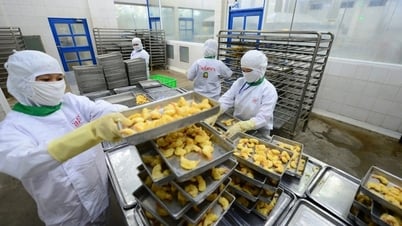Accelerate raw material harvesting
Nam Dan district's cassava starch has been recognized as meeting OCOP standards since 2022, in which the raw material area for cassava starch production is mainly concentrated in Nam Anh commune. Here, in addition to rice, corn, and potatoes, farmers in Nam Anh commune also have a large income from growing cassava. After 11 months of planting, cassava is harvested from November to the end of February every year. The whole Nam Dan district has 300 hectares of cassava, of which Nam Anh commune alone has more than 250 hectares. This plant species is very suitable for the sandy loam soil in the Nam Dan fields, especially the Nam Anh land at the foot of Dai Hue mountain.

In the 2023 crop season, Mr. Tran Dinh Son's household in Hamlet 4, Nam Anh Commune planted 14 hectares of cassava. During the harvest season, he hired an excavator to help dig up cassava tubers. Mr. Son said that this year, people had a good cassava crop, with large tubers and almost no pests or diseases thanks to the warm weather and little rain. Cassava growers in Nam Anh said that cassava had a good crop, with many plants producing 20-30 kg of tubers. With the current purchase price of Dai Hue Cooperative at 19,000 VND/kg, each plant also brings in an income of 400,000 - 600,000 VND.
Mr. Bui Van Xuan planted 2 hectares of cassava. He said that this year, harvesting cassava close to Tet gave his family a decent income to prepare for Tet. With the current selling price, each hectare of cassava planted with about 180 - 200 cassava roots will bring in an income of about 100 million VND/ha. In Nam Anh commune, many households have high income from growing cassava such as Mr. Nguyen Huu Huong's household in hamlet 5; and the households of Mr. Bui Van Xuan, Nguyen Huu Ha, Doan Que Long, and Tran Van Hai in hamlet 4. Small households plant from 1-3 sao, large households plant from 1.5 - 3 ha.
It is expected that in the 2023 crop, harvested in early 2024, Nam Dan district will reach nearly 200 tons of fresh cassava. After harvesting, cassava is washed, ground to filter out the essence, and produces cassava starch that meets the provincial 3-star OCOP standard. During Tet, consumption demand increases sharply, so Mr. Son's cassava starch production facility also operates at full capacity, hiring 4 more workers than usual to deliver Tet orders on time.

OCOP agricultural products are consumed strongly
For many years now, with the advantage of agricultural production, along with Nam Dan district promoting the application of science and technology, dynamic activities, adapting to the market needs of the people, the district's agricultural economy has improved a lot in the direction of goods, especially developing agricultural products that meet OCOP standards. Currently, Nam Dan district leads the whole province in the quantity and quality of OCOP products with a total of 73 products meeting 3 to 4 star standards. In which, mainly agricultural products are processed into food such as cassava starch, soy sauce, tamarind sausage, honey, brown rice, rice vermicelli, salted chicken, products from Uncle Ho's lotus...
One of the typical products of Nam Dan is soy sauce, which is produced by many farming households in the traditional way. For example, Ms. Chu Thi Ha in Hamlet 4, Nam Giang Commune. Since childhood, she has been attached to the flavor of Nam Dan soy sauce made from soybeans, produced by her mother. Ms. Chu Thi Ha has developed her family's product into a commodity, introducing it to consumers across the country. Her mother, Ms. Nguyen Thi Tuyet, is now 85 years old, and has difficulty walking due to old age and poor health, but she still "visits" the soy sauce jars every day, working side by side with her daughter in the stages of producing the typical Nam Dan soy sauce. Ms. Tuyet passed on the techniques of soy sauce production, which require meticulousness, diligence and experience, to her daughter, and she always supports and encourages her daughter to keep the family's traditional profession.

Currently, with the enthusiasm and efforts of all levels and sectors to preserve and develop the brand of OCOP Nam Dan soy sauce, Ms. Chu Thi Ha's production facility is gradually bringing the product to consumers nationwide. On the occasion of Tet, soy sauce orders increased sharply by two or three times compared to normal days. Every day, she packed orders to send to districts in the province and provinces in the country from 30-50 liters, with peak days reaching nearly 100 liters. "Around the 27th of the lunar calendar, we temporarily stopped Tet orders, which was also the time when the jars of soy sauce were empty. After Tet, the family started making the next batches of soy sauce," Ms. Chu Thi Ha shared.
Ms. Ha expressed that, in addition to importing products for agents, grocery stores in the commune, district and some neighboring districts, selling to serve tourists and passersby in the area, she is making efforts to promote on social networking platforms to reach customers in provinces and cities in the country, especially those from Nam Dan who live and work far from home. Ms. Ho Thi Huong - Chairwoman of the Board of Directors, and Director of the Sa Nam Huong Duong Agricultural Cooperative for Production and Processing of Soy Sauce shared: About 2 months before the Lunar New Year, Sa Nam soy sauce was ordered by customers to be shipped 2-3 times higher than usual. Not only consumed domestically in the province but also spread to many other provinces and cities, and in the coming time, Sa Nam soy sauce will be available in many supermarkets across the country.

In addition, OCOP products made from lotus with good quality and eye-catching packaging have become Tet gifts chosen by many people. With 27 lotus varieties grown right in Uncle Ho's homeland in many communes such as Nam Anh, Nam Thanh, Nam Giang, Thuong Tan Loc, Khanh Son..., farmers in Nam Dan district have processed lotus into many valuable gifts, good for health with 11 types of products meeting OCOP standards such as lotus leaf tea, lotus heart tea, lotus jam,...
Mr. Nguyen Hong Son - Deputy Secretary of the District Party Committee, Chairman of the People's Committee of Nam Dan district said that the district always pays attention to supporting people to build OCOP products that ensure quality, with unique local characteristics. Not only serving consumption, OCOP products also aim to serve tourism , contributing to increasing people's income. Therefore, the products selected for the OCOP product development roadmap are key products, with brands and consumption markets in the district, on that basis spreading to markets outside the district and outside the province. Currently, Nam Dan district has 19/19 communes and towns with OCOP products with a total of 73 products.
Source




![[Photo] Prime Minister Pham Minh Chinh and Prime Minister of the Kingdom of Thailand Paetongtarn Shinawatra attend the Vietnam-Thailand Business Forum 2025](https://vphoto.vietnam.vn/thumb/1200x675/vietnam/resource/IMAGE/2025/5/16/1cdfce54d25c48a68ae6fb9204f2171a)




























![[Photo] President Luong Cuong receives Prime Minister of the Kingdom of Thailand Paetongtarn Shinawatra](https://vphoto.vietnam.vn/thumb/1200x675/vietnam/resource/IMAGE/2025/5/16/52c73b27198a4e12bd6a903d1c218846)



























































Comment (0)